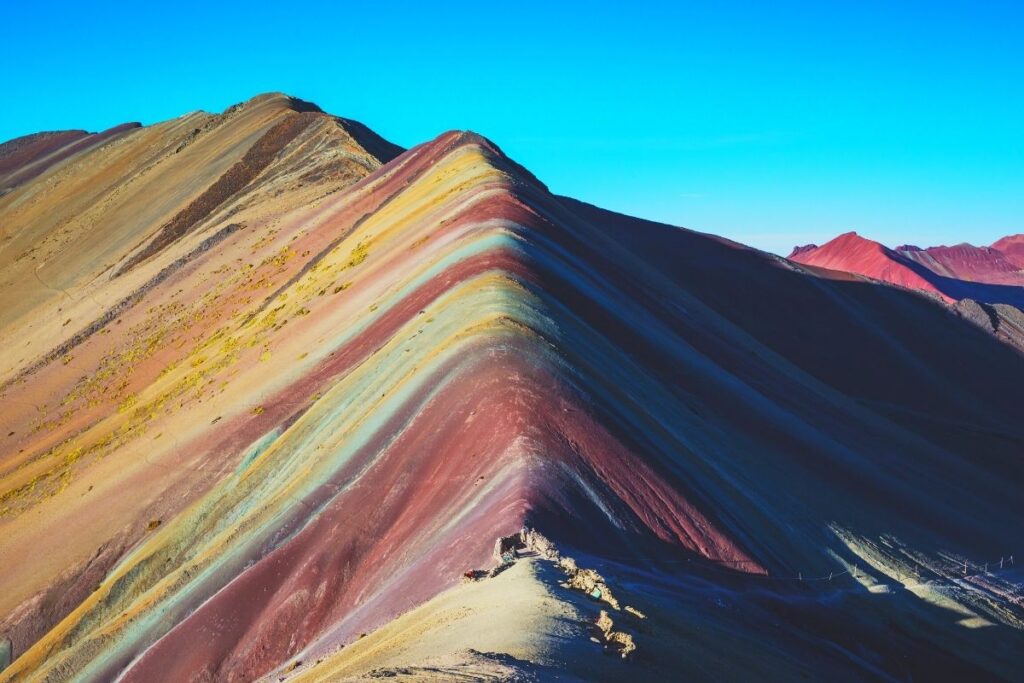The Rainbow Mountains Of China Are Earth’s Paint Canvas
The rainbow mountains of China within the Zhangye Danxia Landform Geological Park are a marvel of the world. These famous Chinese mountains are known for their exotic colours that mimic a rainbow painted on top of rolling mountains.
This is just one example of how geology has attracted our attention and raises the question: What makes rainbow mountains so colourful? Here I will discuss the diagenetic and mineralogical processes that make up red, green, yellow, and blue.
Zhangye Danxia National Park is located in Gansu province in northwestern China, covering 200 square kilometres. The site was named a UNESCO World Heritage Site in 2009 and is home to many Chinese and foreign tourists.

How Did the Rainbow Mountains Form?
The Rainbow Mountains are cretaceous sandstone and siltstone rocks introduced to China before the Himalayas were formed. Sand and mud were mixed with iron and trace minerals that provided an important ingredient to create the colours we see today.
What used to be horizontal and horizontal stratigraphy was interrupted by the Indian Plate colliding with the Eurasian Plate about 55 million years ago. Just as two cars collapsed and bumps collapsed and broke, the same process wrapped up what were flat sandstones in the Rainbow Mountains we see today.

The process lifted the mountains and exposed the rocky clues that hid underground. Climate and erosion have eroded the layers of siliciclastic rocks on the continent and exposed subterranean formations with different mineralogy and chemistry. This results in a surprising variety of colours visible throughout the Rainbow Mountains.
So now that you have an idea of how the rainbow mountains are made, we will talk a bit about how they got the colour we see today. Rainwater runoff carries sandstone grains and deposits trace minerals between the grains.
This rain can grow to a point where there is no more space between the individual seeds, tightening them in place. This process conveys the trace of the minerals mentioned below and allows the international colouring of sandstones worldwide.
The primary colour is a deep red sandstone, unlike the Fountain Formation that flows from Flatirons, Red Rocks Park, and the Garden of the Gods, all of Colorado.
The red colour is caused by the adhesion of iron oxide and cement, also known as hematite (Fe2O3), between sandstone grains. This is the same process when a piece of metal is left out in the rain and forms a red layer of rust on the outside.

The climate, mixed with water and oxygen, releases the basic iron into iron oxide, which is marked by its dark red colour. The Rainbow Mountains are particularly noteworthy for the iron oxide structure of its sandstone Danxia.
Iron oxides often turn a dark red colour. However, there are cases where the oxides form different colours. For example, oxidised limonite or goethite will produce brown or yellow sandstone, and magnetite can form black impurities in sandstones.
If any iron sulphide is present, you will get a yellow metallic colour given by sulphur. Meanwhile, the green colour is usually caused by chlorite clay or silicate metal. These are some examples of how sandstones can be converted into calculation during diagenesis.

Luckily for you, you do not need to go to northwest China to see this same process. Get out and walk around, looking down and out at the landscape. Try to identify the red rock everywhere, and you are more likely to locate iron oxide stained sandstone.
Let us know what you found in the comments below.
Lastly, I will leave you with a few fantastic photos of the Zhangye Danxia Rainbow Mountains.




